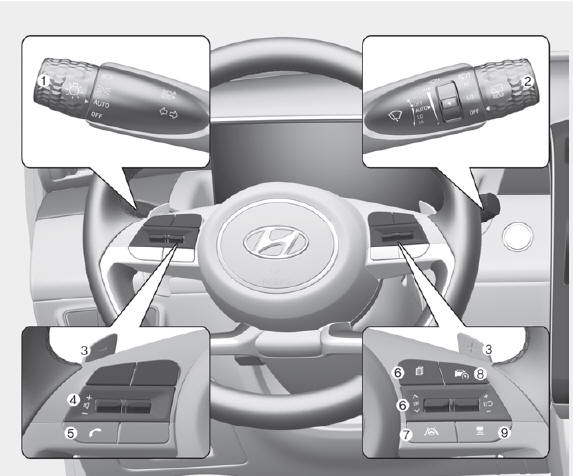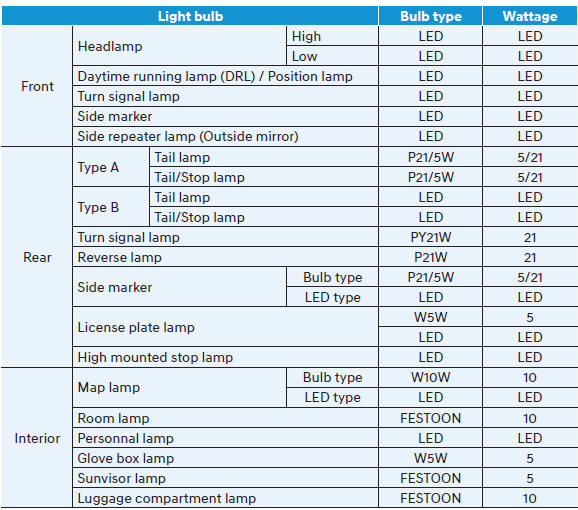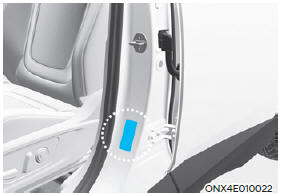Hyundai Tucson: Vehicle Information, Consumer Information and Reporting Safety Defects
Exterior overview (I)
Front view

The actual shape may differ from the illustration
- Hood
- Headlamp
- Tires and wheels
- Side view mirror
- Panoramic sunroof
- Front windshield wiper blades
- Windows
- Front radar
Exterior overview (II)
Rear view

The actual shape may differ from the illustration
- Door Handle
- Fuel filler door
- Rear combination lamp
- Liftgate
- High mounted stop lamp
- Rear window wiper blades
- Antenna
- Rear view camera
Interior overview
Type A

The actual shape may differ from the illustration
- Inside door handle
- Power window switches
- Power window lock button
- Outside rearview mirror control switch
- Driver door lock switch
- Instrument panel illumination control switch
- Power liftgate button
- ESC OFF button
- Steering wheel
- Steering wheel tilt/telescopic lever
- Fuse box
- Hood release lever
- Seat
Type B

- Inside door handle
- Power window switches
- Power window lock button
- Outside rearview mirror control switch
- Driver door lock switch
- Instrument panel illumination control switch
- Power liftgate button
- ESC OFF button
- Steering wheel
- Steering wheel tilt/telescopic lever
- Fuse box
- Hood release lever
- Seat
Instrument panel overview (I)
Type A

- Instrument cluster
- Driver's front air bag
- Engine Start/Stop button
- Infotainment system
- Hazard warning lamp switch
- Climate control system
- Air ventilation seat
- Seat warmer
- Heated steering wheel
- DBC button
- Parking Safety button
- Parking/View button
- Transmission shift button
- EPB (Electronic Parking Brake) switch
- Auto Hold switch
- Drive mode button
- AWD lock button
- ISG (Idle Stop and Go) OFF button
- Passenger's front air bag
- Glove box
- USB port
- Power outlet
- USB charger
- Wireless charging system pad
Type B

- Instrument cluster
- Driver's front air bag
- Engine Start/Stop button
- Infotainment system
- Hazard warning lamp switch
- Climate control system
- Air ventilation seat
- Seat warmer
- Heated steering wheel
- DBC button
- Parking Safety button
- Parking/View button
- Transmission shift lever
- EPB (Electronic Parking Brake) switch
- Auto Hold switch
- Drive mode button
- AWD lock button
- ISG (Idle Stop and Go) OFF button
- Passenger's front air bag
- Glove box
- USB port
- Power outlet
- USB charger
- Wireless charging system pad
Instrument panel overview (II)

- Lighting control lever
- Wiper and washer control lever
- Paddle shifter
- Audio remote control buttons
- Bluetooth hands-free phone button
- LCD display control
- Lane Driving Assist button
- Driving Assist button
- Vehicle Distance button
Engine compartment
Smartstream G2.5 GDI

The actual engine compartment in the vehicle may differ from the illustration
- Engine coolant reservoir
- Brake fluid reservoir
- Air cleaner
- Engine oil dipstick
- Engine oil filler cap
- Windshield washer fluid reservoir
- Fuse box
- Battery
Dimensions

Engine

Bulb wattage

Tires and wheels

NOTICE
- It is permissible to add 3 psi to the standard tire pressure specification if colder temperatures are expected soon.
Tires typically lose 1psi (7kPa) for every 12ºF temperature drop. If extreme temperature variations are expected, recheck your tire pressure as necessary to keep them properly inflated.
- Tire inflation pressures will vary with changes in elevation. If driving in areas of higher or lower elevation, be sure to check and adjust for proper tire inflation.
CAUTION
- When replacing tires, use the same size originally supplied with the vehicle.
Using tires of a different size can damage the related parts or not work properly.
- When replacing tires, ALWAYS use the same size, type, construction and tread pattern supplied with the vehicle for all tires.
Air conditioning system

Contact an authorized HYUNDAI dealer for more details.
Volume and weight

Recommended lubricants and capacities
To help achieve proper engine and powertrain performance and durability, use only lubricants of the proper quality. The correct lubricants also help promote engine efficiency that results in improved fuel economy.
These lubricants and fluids are recommended for use in your vehicle.

*1 : Refer to the recommended SAE viscosity numbers.
*2 : Requires <API Latest (or ILSAC Latest) Full synthetic> grade engine oil. If a lower grade engine oil (mineral oil including Semi-synthetic) is used, then the engine oil and engine oil filter must be replaced as indicated severe maintenance condition.
Recommended SAE viscosity number
CAUTION
Always be sure to clean the area around any filler plug, drain plug, or dipstick before checking or draining any lubricant. This is especially important in dusty or sandy areas and when the vehicle is used on unpaved roads. Cleaning the plug and dipstick areas will prevent dirt and grit from entering the engine and other mechanisms that could be damaged.
Engine oil viscosity (thickness) has an effect on fuel economy and cold weather operating (engine start and engine oil flowability). Lower viscosity engine oils can provide better fuel economy and cold weather performance, however, higher viscosity engine oils are required for satisfactory lubrication in hot weather. Using oils of any viscosity other than those recommended could result in engine damage.
When choosing an oil, consider the range of temperature your vehicle will be operated in before the next oil change. Proceed to select the recommended oil viscosity from the chart.

*1 : Requires <API SN PLUS (or above) Full synthetic> grade engine oil. If a lower grade engine oil (mineral oil including Semi-synthetic) is used, then the engine oil and engine oil filter must be replaced as indicated for severe maintenance condition.
 An engine oil displaying this API Certification Mark conforms to the international Lubricant Specification Advisory Committee (ILSAC). It is recommended to only use engine oils that uphold this API Certification Mark.
An engine oil displaying this API Certification Mark conforms to the international Lubricant Specification Advisory Committee (ILSAC). It is recommended to only use engine oils that uphold this API Certification Mark.
Vehicle Identification Number (VIN)
Frame number

The vehicle identification number (VIN) is the number used in registering your vehicle and in all legal matters pertaining to its ownership, etc.
The number is punched on the body panel between the engine and the interior of the vehicle.
VIN label (if equipped)

The VIN is also on a plate attached to the top of the left side dashboard. The number on the plate can easily be seen through the windshield from outside.
Vehicle certification label

The vehicle certification label attached on the driver's (or front passenger's) side center pillar gives the vehicle identification number (VIN).
Tire specification and pressure label

The tires supplied on your new vehicle are chosen to provide the best performance for normal driving.
The tire label located on the driver's side center pillar gives the tire pressures recommended for your vehicle.
Engine number
Smartstream G2.5 GDI

The engine number is stamped on the engine block as shown in the drawing.
Refrigerant label

The refrigerant label provides information such as refrigerant type and amount. (R-1234yf)
Consumer Information
This consumer information has been prepared in accordance with regulations issued by the National Highway Traffic Safety Administration of the U.S. Department of Transportation. Your HYUNDAI dealer will help answer any questions you may have as you read this information.
HYUNDAI motor vehicles are designed and manufactured to meet or exceed all applicable safety standards.
For your safety, however, we strongly urge you to read and follow all directions in this Owner's Manual, particularly the information under the headings "NOTICE", "CAUTION" and "WARNING".
READ NEXT:
 Important safety precautions
Important safety precautions
This chapter provides you with important information about how to protect
yourself and your
passengers. It explains how to properly use your seats and seat belts, and how
your air bags work.
Additionally, this chapter explains how to properly
 Seats
Seats
The information provided may differ depending on which functions are
applicable to your vehicle.
Front seat
Forward and rearward
Seatback angle
Seat cushion angle*
Seat cushion height
Lumbar support (Driver's seat)*
Seat warmer*
A
SEE MORE:
 ESC Control unit (HECU)
ESC Control unit (HECU)
Components
Front - right (FR)
Rear - left (RL)
Rear - right (RR)
Front - left (FL)
MC2
MCI
ESC Control unit (HECU) connector
Bracket
ESC Control unit (HECU)- Removal
Removal
Disconnect the battery negative ( - ) terminal.
 Vehicle load limit
Vehicle load limit
Two labels on your driver's door sill show
how much weight your vehicle was
designed to carry: the Tire and Loading
Information Label and the Certification
Label.
Before loading your vehicle, familiarize
yourself with the following terms for
Information
- Home
- Hyundai Tucson - Fourth generation (NX4) - (2020-2023) - Owner's Manual
- Hyundai Tucson - Fourth generation (NX4) - (2020-2023) - Workshop Manual